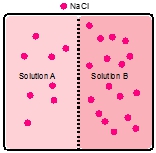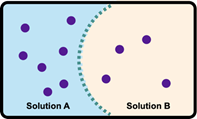We know that osmosis is the movement of a solvent from an area of low concentration to an area of high concentration. Now, the direction of solvent flow depends on tonicity. Tonicity itself is just the relative concentration of solutes dissolved in the solutions. Now, when we take a look at the different types of solutions realize that we're looking at solute concentration and osmotic pressure relative to one another. If we take a look here, we have our hypotonic solution, our isotonic solution, and our hypertonic solution. With a hypotonic solution, it has a lower solute concentration and lower osmotic pressure relative to bodily fluids. And when we talk about isotonic solutions, this is when two solutions have the same solute concentration and osmotic pressure. Now, an interesting piece of information is when we deal with intravenous solutions, they must be isotonic to bodily fluids such as blood, plasma, tissue cells, tissue fluids, etcetera. And then finally, we have hypertonic solutions which have a higher solute concentration and osmotic pressure relative to body fluids.
Now, if we take a look here, we're going to talk about hypotonic, isotonic, and hypertonic environments and look at them in reference to their solute concentrations outside the cell, osmotic pressure outside the cell, and the effects they have on red blood cells. So, when we're looking at hypotonic solutions, we're going to say they have lower solute concentration. We said isotonic they would have equal solute concentrations between two things being compared to one another. Hypertonic would have higher solute concentration. Now, what about their osmotic pressure outside the cell? Well, lower solute concentration would result in lower osmotic pressure. Here, the equal amount of solute concentration would equate to an equal osmotic pressure. Higher solute concentration will result in higher osmotic pressure. What effect does this have on a biological system such as a red blood cell? Well, here we're going to say that we have a lower concentration on the outside, so that would mean that it's more concentrated within the red blood cell. So remember, osmosis moves to where it's higher in concentration. So water would enter the cell. This causes a process known as hemolysis. So basically, the cell will swell up because all the water is going in there, and if too much water gets in there, it can burst. Okay, so a cell will swell and then could burst. Next, we have an isotonic environment. So the concentration inside and outside the red blood cell are the same. So water enters and exits the cell at equal rates so there is no net movement of water. The same amount that goes in is the same amount that comes out. Finally, if we're in a hypertonic environment that means that it's more concentrated on the outside of the red blood cell, so water is going to exit the cell. If enough water exits the cell, this causes cremation, so the cell will dehydrate and shrivel.
Now, how's the way for us to remember these different types of situations? Well, here let's say we're looking at a hypotonic environment. So a hypotonic environment, hypo sounds close to hippo. Hippos drink, a hippo drinks too much water and swells like a cell. So hippos will take in a huge amount of water because the environment is hypotonic and they could burst or swell. Hypertonic environment, so the outside is more concentrated than the red blood cell. So a hypertonic environment can be related to a hyper kid. The hyper kid playing outside gets dehydrated like a cell. So if your environment is hypertonic, you're going to lose water out of your red blood cell. It's going to exit the red blood cell and try to dilute the outside environment. So just keep these little memory tools to help you know the distinction between hypotonic versus hypertonic. Isotonic, we know everything is equal on the inside and out so there's no net movement of water.






 are the solute particles.
are the solute particles.

